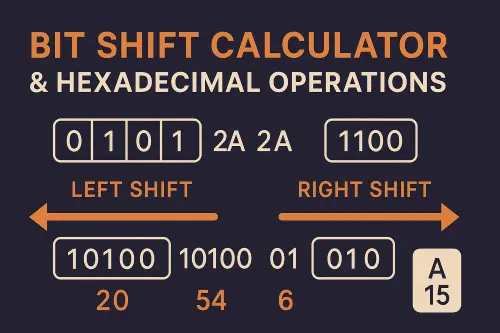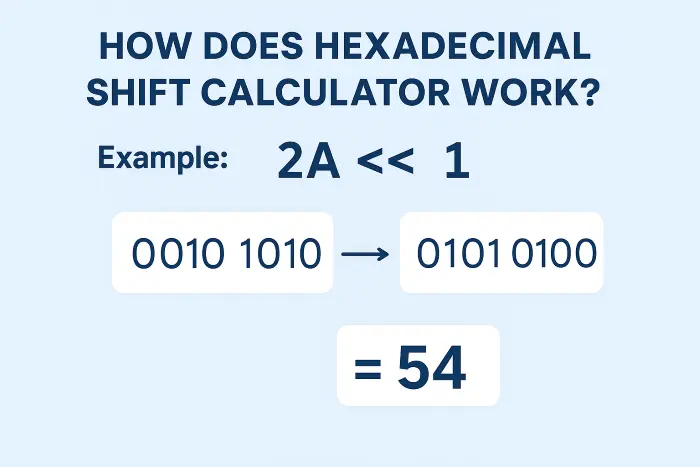Hexadecimal Shift Calculator
What is a Bit Shift Calculator?

A bit shift calculator is a powerful mathematical tool that performs binary digit manipulation operations, moving bits left or right within a number’s binary representation. These calculators execute fundamental computer science operations that form the backbone of digital computation, offering precise results across binary, decimal, and hexadecimal number systems.
When working with bit shifting, you’ll often need to convert between different number systems. Our binary to hexadecimal converter seamlessly handles these transformations, while the decimal to binary calculator helps you understand the underlying binary patterns before applying shift operations.
Bit shifting operations occur at the processor level in all digital devices, making these calculations essential for programmers, engineers, and students working with low-level computing concepts. Whether you’re optimizing algorithms, working with memory addresses, or understanding digital logic circuits, combining a hexadecimal calculator with bit shift operations provides immediate, accurate results for complex mathematical transformations.
Understanding Left Shift Operations
Mathematical Foundation of Left Shifting
Left shift operations move every binary digit one position to the left, introducing zeros on the right side. This fundamental operation follows a precise mathematical formula: Result = Original Number × 2^n, where n represents the number of shift positions.
Consider shifting the binary number 0101 (decimal 5) left by two positions. You can verify this calculation using binary calculator: the operation transforms 0101 into 10100, which equals decimal 20. To double-check this result, use binary to decimal converter to confirm that 10100 equals 20. This demonstrates the core principle: 5 × 2² = 5 × 4 = 20.
Practical Left Shift Examples with Calculator Tools
When working with hexadecimal values, left shifting maintains the same mathematical relationship. The hex value 2A (decimal 42) shifted left by one position becomes 54 (decimal 84). You can verify these conversions using our hex to decimal converter to confirm that 2A equals 42, and our decimal to hex calculator to verify that 84 equals 54 in hexadecimal.
For complex calculations involving multiple number systems, try multi-base calculator which handles binary, decimal, and hexadecimal operations simultaneously. Programming languages represent left shift operations using the << operator, and you can practice these operations with our interactive bitwise operation calculator.
Right Shift Operations Explained
Logical vs Arithmetic Right Shifts
Right shift operations move binary digits toward the right, but the treatment of the leftmost positions varies between logical and arithmetic shifts. Logical shift calculator always fills vacant left positions with zeros, while the arithmetic shift calculator preserves the sign bit in signed number representations.
For unsigned numbers, right shifting by n positions equals integer division by 2^n with truncation of remainders. Use division calculator to verify these relationships: the binary sequence 1100 (decimal 12) becomes 0110 (decimal 6) after one right shift, demonstrating division: 12 ÷ 2 = 6.
Right Shift Mathematical Properties
Right shift calculations follow the formula: Result = Original Number ÷ 2^n (with integer truncation). This makes right shifting valuable for fast division operations in performance-critical applications. Test this relationship with integer division calculator.
The hexadecimal value FF (decimal 255) shifted right by 4 positions becomes 0F (decimal 15). Verify this using hex shift calculator, then confirm the division relationship with hex division calculator: 255 ÷ 16 = 15.9375, truncated to 15.
Hexadecimal Number System Fundamentals

Base-16 Representation and Conversion Tools
The hexadecimal system uses sixteen symbols (0-9, A-F) to represent values 0 through 15. This base-16 notation provides compact representation for binary data, where each hex digit corresponds exactly to four binary bits. Our online hex calculator supports all standard arithmetic operations in base-16.
The relationship between hexadecimal and binary creates seamless conversion opportunities. Use our hex to binary converter to see how hex digit C equals binary 1100, while hex digit 7 represents binary 0111. For reverse conversions, our binary to hex calculator handles multi-digit transformations instantly.
Hexadecimal Arithmetic Operations
Hexadecimal calculations follow standard arithmetic principles adapted to base-16. Our hex addition calculator handles carrying operations when sums exceed F (15). For example, A + 8 = 12 (hex), since 10 + 8 = 18, and 18 in hex equals 12.
Multiplication in hexadecimal maintains positional notation rules. Use our hex multiplication calculator to verify that 3 × C equals 24 (hex), since 3 × 12 = 36, and 36 in decimal converts to 24 in hexadecimal using our decimal to hex converter.
Advanced Bit Manipulation Techniques
Circular Shift Operations and Specialized Calculators
Circular shifts (rotations) move bits that fall off one end back to the other end, preserving all original bit information. Circular shift calculator demonstrates how these operations differ from standard shifts that introduce new zeros.
A left circular shift of 1101 by one position produces 1011, where the leftmost 1 moves to the rightmost position. Compare this with standard left shifting using our left shift calculator to understand the difference. This operation proves essential in cryptographic algorithms, which you can explore with crypto bit calculator.
Bitwise Logical Operations
Bit manipulation extends beyond shifting to include logical operations like AND, OR, XOR, and NOT. Our comprehensive bitwise AND calculator, bitwise OR calculator, and bitwise XOR calculator work on corresponding bit positions between operands.
The XOR operation proves particularly valuable for encryption and error detection. Use our XOR calculator to see how XORing any value with itself produces zero, while XORing with zero leaves the original value unchanged. For complement operations, try our bitwise NOT calculator.
Number Base Conversion Strategies
Binary to Hexadecimal Conversion
Converting binary to hexadecimal leverages the four-bit grouping relationship. Our binary to hexadecimal converter automatically handles this grouping process. Starting from the right, group binary digits into sets of four, then convert each group to its hex equivalent.
The binary number 11010110 groups as 1101|0110, converting to D6 in hexadecimal. Verify this step-by-step with binary grouping calculator, then use 4-bit to hex converter to see how 1101 equals D and 0110 equals 6.
Decimal to Binary Conversion Method
Decimal to binary conversion uses successive division by 2, collecting remainders to build the binary representation. Decimal to binary calculator automates this process, but you can practice manually with division by 2 calculator.
Converting decimal 89 involves multiple division steps. Use remainder calculator to track each step: 89÷2=44 remainder 1, 44÷2=22 remainder 0, continuing until reaching 0. Binary construction tool helps visualize building the final result by reading remainders in reverse order.
Hexadecimal to Decimal Calculation
Hexadecimal to decimal conversion applies positional notation where each digit’s value equals the digit times 16 raised to its position power. Our hex to decimal calculator performs these calculations instantly, while our positional notation calculator shows the mathematical breakdown.
The hex number 1A3 converts through hex positional calculator as: (1×16²) + (10×16¹) + (3×16⁰) = 256 + 160 + 3 = 419. Verify each power calculation with power of 16 calculator.
Real-World Applications
Memory Address Calculations
Computer memory systems extensively use hexadecimal addressing due to its natural alignment with binary word sizes. Memory address calculator helps convert between different addressing formats, while pointer arithmetic calculator handles address calculations.
Bit shifting enables efficient address arithmetic. Use array index calculator to see how multiplying an index by element size works. For 4-byte integers, left shift by 2 calculator demonstrates how shifting left by 2 positions (multiplication by 4) yields the correct byte offset.
Digital Color Representation
Web development relies on hexadecimal color codes where six hex digits represent RGB color components. Our hex color calculator breaks down colors like #FF6A00 into FF (255 red), 6A (106 green), and 00 (0 blue) components.
Bit manipulation facilitates color processing algorithms. RGB extraction calculator shows how extracting red components requires right shifting by 16 positions, while color masking calculator demonstrates masking operations. For brightness adjustments, try color scaling calculator.
Cryptographic Implementation
Modern encryption algorithms employ extensive bit manipulation for security transformations. AES calculator demonstrates how the Advanced Encryption Standard uses rotating shifts and XOR operations, while substitution box calculator shows cryptographic substitution tables.
Hash functions like SHA-256 rely on bit shifting patterns to create avalanche effects. Use SHA-256 calculator to see how single bit changes produce different outputs, and our avalanche effect calculator to measure these differences quantitatively.
Performance Optimization Techniques
Computational Efficiency Benefits
Bit shift operations execute significantly faster than multiplication and division on most processors. Our performance comparison calculator demonstrates speed differences between shift operations and traditional arithmetic.
Modern compilers automatically optimize appropriate operations, but manual optimization remains valuable. Use our optimization analyzer to identify opportunities for replacing multiplication with shifts, and our compiler output simulator to see how different approaches translate to machine code.
Memory-Efficient Algorithms
Bit manipulation enables compact data storage through bit packing techniques. Our bit packing calculator shows how to store multiple boolean flags in single integers, while our memory efficiency calculator quantifies storage savings.
Fixed-point arithmetic systems use bit shifting for fractional representation. Try our fixed-point calculator to see fractional values without floating-point hardware, and our Q-format calculator for digital signal processing applications.
Common Calculation Pitfalls
Overflow and Underflow Conditions
Bit shifting operations can cause data loss when shifted bits exceed available bit width. Our overflow detector identifies potential issues before they occur, while our bit width calculator helps determine safe operation ranges.
Sign Extension Errors
Signed number systems require careful sign bit handling during right shifts. Our sign extension calculator shows proper handling techniques, while our two’s complement calculator handles signed number representation.
Precision Accumulation Issues
Multiple shift operations can compound precision losses. Our precision tracker monitors cumulative errors, while our error accumulation calculator quantifies precision loss over multiple operations.
Calculator Tool Integration
Input Format Flexibility
Modern bit shift calculators accept input in multiple formats. Our universal number converter handles binary (101010), decimal (42), and hexadecimal (2A) inputs seamlessly, eliminating manual conversion steps.
Educational Features
Advanced calculators provide step-by-step explanations showing bit movement visualization. Our step-by-step bit calculator demonstrates underlying principles, while our visual bit shifter provides animated representations.
Frequently Asked Questions
What’s the difference between logical and arithmetic right shifts?
Logical right shift calculators always fill leftmost positions with zeros, suitable for unsigned numbers. Arithmetic right shift calculators preserve the sign bit, maintaining correct values for signed numbers in two’s complement representation.
How do bit shifts relate to multiplication and division?
Left shifts multiply by powers of 2, while right shifts divide by powers of 2. Our multiplication by shifting calculator demonstrates these relationships, and our division by shifting calculator shows truncation effects.
Why use hexadecimal instead of binary for programming?
Hexadecimal provides compact notation where each digit represents exactly 4 binary bits. Our hex vs binary comparison tool shows length differences, while our programmer’s calculator demonstrates practical applications in memory addressing and debugging.
Can bit shifting work with negative numbers?
Yes, but requires careful consideration of sign representation. Our negative number shift calculator handles signed values correctly, while our sign preservation analyzer shows potential issues with different shift types.
What happens when shifting exceeds the number size?
Shifting beyond the bit width typically uses modulo arithmetic. Our modulo shift calculator demonstrates how shifting a 32-bit number by 35 positions equals shifting by 3 positions (35 mod 32 = 3). Use our bit width validator to check safe shift ranges.
